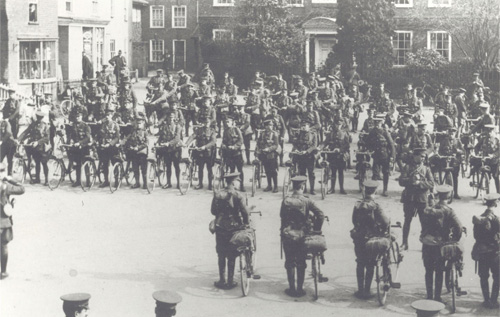The October picture in the Reepham Life 2018 Calendar shows several cyclists in Reepham’s Market Place, photographed after 1987.
The photograph below shows men from a First World War cycle regiment on parade in the Market Place, possibly 1916. Some may have been billeted in the area. (An archive photograph shows two soldiers on Reepham Moor with rifles on their bicycles.)

A bicycle was an ideal means of transportation as it was comparatively lightweight. It could be carried over obstructions and, as well as being ridden, could be loaded with equipment and pushed. A motorcycle was faster, but a bicycle was silent.
Volunteer cyclist units started in Great Britain in the 1880s. The official Army Cyclist Corps was formed in 1914.
In the early days military cyclists proved their worth, and there were numerous reports of their bravery in the British cycling press. But trench warfare forced the reassignment of soldiers from cyclist units to infantry units, and although bicycles were still used extensively throughout the war by all sides, there was less need for actual cyclist units.
A cyclist’s duties included reconnaissance, security patrols and courier work. Cyclists were used to cycle along communications trenches, which was particularly important if the security of the trench telephone system was found to have been compromised by enemy receiving stations.
The British Army’s Cyclist Training Manual 1907 (as revised in 1911) was replete with items as how to salute while standing by, sitting on and riding the bicycle, drill movements such as “Ground Cycles”, “Take Up Cycles” and “Stack and Unstack Cycles”, and helpful advice on care of bicycles such as “Bicycle tyres should be wiped with a damp cloth after a march, so that all grit, which if left might cause a puncture, may be removed.”
Janet Archer
The Reepham Archive is open to the public on the first Wednesday and Saturday of the month from 10 am – 12 noon (or by appointment), upstairs in the Bircham Centre, Market Place, Reepham. Email: reephamarchive@gmail.com
